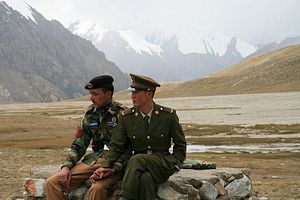Kristina Kironska and Jeremy Garlick

For years, the leaders of China and Pakistan have eulogized the relationship between the two countries as “higher than the mountains, deeper than the oceans, sweeter than honey.” Then-Prime Minister Nawaz Sharif promoted the China-Pakistan Economic Corridor (CPEC) – an infrastructure investment megaproject in Pakistan financed by China since 2015 – as a “game changer.” Now there is firm evidence in the form of survey data that such phrases are more than just rhetoric – at least as far as the citizens of Pakistan are concerned.
As part of the Sinophone Borderlands public opinion survey in Pakistan in June 2022, over 1,200 Pakistani respondents were asked two open-ended questions about their perception of China. Respondents were drawn from all regions of Pakistan and included a representative sample of age groups and genders. The same questions have also been asked in many other countries and very rarely have the answers been as significantly positive as in Pakistan.
The first survey question asked what first came to people’s minds when thinking of China. The most common answers, as the word cloud reveals, were “friend,” “best friend,” “good friend,” and even “trusted friend.” Chinese people were perceived as friendly and hardworking. The country itself was seen as being strong, and developed, with many respondents labeling it a superpower. Also, China was seen as helpful and supportive of Pakistan. The connection between the two countries was described as a “brotherhood” and many people celebrated it by saying “long live Pak-China friendship.”
The second question asked whether people’s general view of China got better or worse during the previous three years and why. An overwhelming majority of the Pakistani respondents (85 percent) gave a positive answer. Only 9 percent indicated a worsening of their perception, and 6 percent stayed neutral. Those who indicated seeing China in a worse light than before identified reasons like COVID-19, China working only for its own benefit, and China’s treatment of Muslims (this was the most common answer among the negative answers). People whose perception got better focused mostly on China’s support to Pakistan in the form of CPEC, Chinese investment, or even China’s COVID-19 support.
The results prompt an important question: Why are the attitudes of Pakistanis so overwhelmingly positive toward China, and why so much more so than in other countries? The answer is that their positive attitudes are linked to China’s long-term support for Pakistan, especially through CPEC, and Pakistan’s otherwise rather isolated position in South Asia, where it lacks other firm allies.
In particular, the positive attitude correlates with Chinese investments flowing into the country under the label of CPEC, which was frequently mentioned by the respondents. Although the CPEC investment program has progressed more slowly than expected, especially with regard to the development of Gwadar port in Balochistan province, there have been notable successes. Transport and energy infrastructure, so badly needed in Pakistan, have been built. New power plants have added energy to Pakistan’s power grid. Roads and railways are being constructed. The ML-1 connection linking Karachi with the northern city of Peshawar is the most significant project under construction by Chinese companies. ML-1 is employing an estimated 24,000 workers and will ultimately cost around $6.8 billion. However, more work needs to be done, especially with regard to energy, since Pakistan is still prone to blackouts.
Nevertheless, what drives China’s popularity among the citizens of Pakistan is that China is really Pakistan’s one and only stalwart ally. It is the only country that is currently willing to invest in Pakistan on a large scale. India is a mutual enemy, while the United States has clearly given up on Pakistan since the withdrawal from Afghanistan. The U.S. is also China’s geopolitical rival. As far as other possible candidates for aid are concerned, Russia is supplying arms to India, and Pakistan has mixed relations with its other neighbors such as Iran and Afghanistan. Meanwhile, even though there are problems with the CPEC megaproject, it is the only game in town. China also continues to supply Pakistan’s military with the majority of its arms imports.
At the same time, even in the face of overwhelming popular support, it is necessary to be pragmatic about the progress of Chinese investments and not to exaggerate what can be achieved. For instance, in mid-2022 the non-repayment of loans induced Chinese power companies to turn off energy supplies, contributing to blackouts. Locals in Gwadar have not bought into the benefits of the Chinese-constructed port, leading to protests and slowing down the implementation of the project. The notion that CPEC can be a “game changer” is still far from realization since Chinese investments alone are insufficient to transform Pakistan’s troubled economy.
It is certainly encouraging for the growth of China-Pakistan relations that people in Pakistan are so positive about their Chinese ally. Still, having a good image is not sufficient on its own to enact the economic transformation of a less-developed partner, particularly one with cashflow problems. Unrealistic expectations of cooperation are only likely to lead to disappointment in the long run.
It should also be remembered that what really binds China and Pakistan together is their mutual mistrust of India, with whom both have border disputes in the Kashmir region. In this case, given the history of conflict between China and Pakistan on one side and India on the other, the ties that bind are as much geopolitical as geoeconomic. The relatively slow implementation of Chinese infrastructure investment projects in Pakistan bears witness to the fact that security cooperation, with Chinese arms propping up Pakistan’s military, is as much of a priority as economic transformation. Indeed, it is likely that the former is more significant than the latter – at least, as far as the perennially pressured leaders of the two countries, both of which also have to contain internal separatism, are concerned.
No comments:
Post a Comment